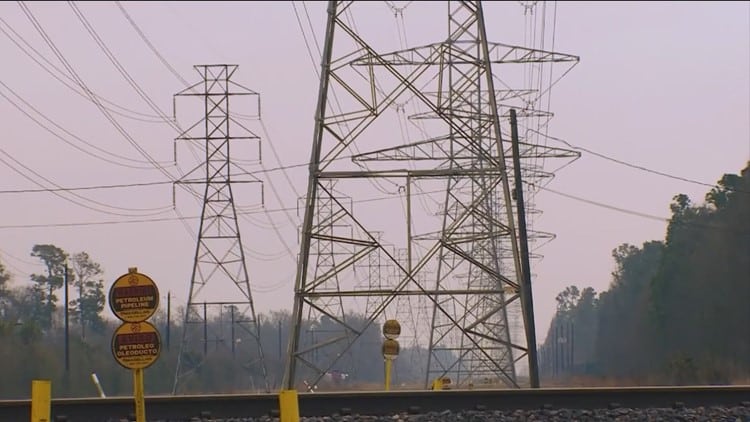Weather Watch Going in Effect in Texas Starting Wednesday
A weather watch will be in effect in Texas starting Wednesday, bringing potential severe conditions. Texas residents should be prepared for severe weather conditions as a weather watch will be implemented from Wednesday onwards.
This alert indicates the possibility of hazardous conditions such as heavy rain, strong winds, hail, and even tornadoes. It is crucial for individuals and communities to stay informed and take necessary precautions to ensure safety. Being aware of the forecast and staying tuned to local weather updates can help mitigate risks and respond effectively to any emergencies.
It is advisable to secure outdoor objects, stay indoors if possible, and have emergency kits ready. By staying prepared and alert, Texans can minimize the impact of severe weather and protect themselves and their property.
What Is A Weather Watch?
A Weather Watch will be in effect in Texas starting Wednesday, alerting residents to potential weather hazards. Stay updated for any important weather updates to ensure your safety.
Definition And Explanation Of A Weather Watch
A weather watch is a notification issued by meteorological agencies to alert the public about the possibility of hazardous weather conditions. It is a proactive measure designed to keep individuals informed and prepared for potential disruptions to daily life. Weather watches are typically issued when there is a reasonable chance of severe weather occurring within a specific area.
Key points about weather watches include:
- Weather watches serve as early warnings, allowing people to monitor the developing situation closely.
- They are issued in advance to give individuals and communities time to prepare and stay safe.
- Weather watches cover a range of potential hazards such as thunderstorms, tornadoes, hurricanes, blizzards, or heatwaves.
- Watch notifications provide information on the expected timing, intensity, and geographical area likely to be affected by the hazardous weather conditions.
How A Weather Watch Is Different From A Weather Warning
While weather watches and weather warnings sound similar, they have distinctive meanings and implications. Understanding the difference is crucial to appropriately responding to each type of notification.
Here are the key differentiating factors:
- A weather watch indicates that the potential for hazardous weather exists in a particular area. It serves as an alert for individuals and communities to stay informed and be prepared. The hazardous conditions are possible but not yet occurring.
- On the other hand, a weather warning is issued when the hazardous weather conditions are imminent or already happening. Warnings are more urgent and instructive, requiring immediate action to ensure personal safety and protection.
It is important to note that weather watches can be upgraded to warnings if the conditions escalate and become more severe. Therefore, staying updated and heeding official instructions is essential.
Importance Of Weather Watches In Keeping The Public Informed
Weather watches play a vital role in keeping the public informed and ensuring their safety during hazardous weather events. They serve several important purposes:
- Early Awareness: Weather watches provide advanced notice of potential hazardous conditions, giving individuals time to take necessary precautions and make informed decisions.
- Preparation: They allow individuals to prepare their homes, secure outdoor belongings, stock up on supplies, and develop emergency plans.
- Stay Informed: Weather watches prompt people to stay tuned to reliable weather sources, such as local news or meteorological agencies, for updates on the evolving situation.
- Personal Safety: By staying aware of weather watches, individuals can adjust their activities and avoid dangerous situations. For example, they may postpone outdoor events or seek shelter in case of severe thunderstorms or tornadoes.
- Timely Action: Weather watches enable individuals to take proactive measures to protect themselves and their property, minimizing potential damage and injuries.
Weather watches are crucial tools that help keep the public informed, enabling them to prepare adequately for potential hazardous weather conditions. By staying alert and proactive, individuals can ensure their safety and well-being during severe weather events.
/cloudfront-us-east-1.images.arcpublishing.com/dmn/YSSOOUON5VB3LGZ2MBA23CGB2Y.jpg)
Credit: www.dallasnews.com
Understanding Texas Weather Patterns
Texans should brace themselves as a weather watch takes effect starting Wednesday, bringing changes in the state’s weather patterns. Stay prepared for potential disruptions and stay informed about any updates.
Overview Of The Typical Weather Patterns In Texas
- Texas experiences a varied range of weather patterns, largely influenced by its size and geographical diversity.
- Summers in Texas are hot and dry, with temperatures often soaring above 100 degrees Fahrenheit.
- Winters are relatively mild, with average temperatures ranging from the 40s to 60s degrees Fahrenheit.
- Spring and fall seasons bring pleasant weather with mild temperatures, making them the preferred seasons for outdoor activities.
- Texas is prone to severe weather events, such as hurricanes, tornadoes, thunderstorms, and flash floods.
Factors That Contribute To Severe Weather In The Region
- The position of Texas in relation to the Gulf of Mexico makes it susceptible to hurricanes and tropical storms, especially along the coastal areas.
- The collision of dry air from the north and moist air from the Gulf of Mexico creates an ideal environment for thunderstorm formation.
- Texas sits in “Tornado Alley,” a region prone to tornadoes due to the clash of warm, moist air from the Gulf of Mexico and cooler, drier air from the Rocky Mountains.
- The size and topography of Texas contribute to localized weather patterns, with the western regions experiencing drier conditions and the eastern regions receiving higher rainfall amounts.
Historical Data On Severe Weather Events In Texas
- Texas has a long history of severe weather events, including devastating hurricanes like Hurricane Harvey in 2017 and Hurricane Ike in 2008.
- Tornadoes are also a frequent occurrence in Texas, with several hundred tornadoes reported annually, causing significant damage and posing a threat to lives.
- Flash floods are common, especially in areas with poor drainage systems, leading to property damage and potential dangers for residents.
- Texas also experiences hailstorms, which can cause extensive damage to vehicles, crops, and buildings.
Texas weather patterns are diverse, ranging from scorching summers to mild winters. The state’s size and geographical location expose it to various weather phenomena. Let’s delve into the typical weather patterns, factors contributing to severe weather, and historical data on severe weather events.
Overview Of The Typical Weather Patterns In Texas
- Summers: Hot and dry, with temperatures often exceeding 100 degrees Fahrenheit.
- Winters: Mild with average temperatures ranging from the 40s to 60s degrees Fahrenheit.
- Springs & Falls: Pleasant weather with milder temperatures, ideal for outdoor activities.
- Severe Weather: Prone to hurricanes, tornadoes, thunderstorms, and flash floods.
Factors That Contribute To Severe Weather In The Region
- Gulf of Mexico Influence: Texas’s proximity to the Gulf of Mexico makes it susceptible to hurricanes and tropical storms.
- Clash of Air Masses: The convergence of dry air from the north and moist air from the Gulf of Mexico creates thunderstorm-prone conditions.
- “Tornado Alley” Location: Texas lies within the region known as Tornado Alley, where warm, moist Gulf air collides with cooler air from the Rocky Mountains, leading to tornado formation.
- Topography: Texas’s size and varied topography influence localized weather patterns and precipitation levels.
Historical Data On Severe Weather Events In Texas
- Hurricanes: Texas has experienced devastating hurricanes such as Hurricane Harvey in 2017 and Hurricane Ike in 2008, causing extensive damage and impacting lives.
- Tornadoes: Hundreds of tornadoes occur in Texas each year, posing risks to communities and resulting in property damage.
- Flash Floods: Poor drainage systems contribute to frequent flash floods in certain areas, leading to property damage and potential hazards.
- Hailstorms: Texas is prone to hailstorms, which can wreak havoc on vehicles, crops, and infrastructure.
The Impending Weather Situation
A Weather Watch has been issued for Texas starting Wednesday, signaling an impending weather situation. Residents are advised to stay updated on the changing conditions.
Details About The Specific Weather Conditions Expected In Texas Starting Wednesday
- Heavy rainfall is predicted for Texas starting from Wednesday, with estimates ranging from 3 to 6 inches.
- A slow-moving low-pressure system will bring significant precipitation, potentially leading to localized flooding in low-lying areas.
- Strong thunderstorms are anticipated, accompanied by gusty winds of up to 40 mph.
- The region is expected to experience a drop in temperatures, with highs in the mid-70s and lows in the upper 50s.
- The rainfall is expected to persist for several days, gradually tapering off by the end of the week.
Explanation Of The Meteorological Forecast For The Region
- This weather system is the result of a collision between a cold front moving southward and moist air from the Gulf of Mexico.
- As the cold front displaces the warm air, it creates atmospheric instability, leading to the development of thunderstorms and heavy precipitation.
- Meteorologists are closely monitoring this pattern, as unstable weather systems can be challenging to predict accurately.
- Doppler radar and other advanced meteorological tools will aid in tracking the movement and intensity of these storms.
Potential Impacts Of The Weather On The Local Communities
- The heavy rainfall and thunderstorms pose a risk of flash flooding, particularly in urban areas and regions with poor drainage systems.
- It is crucial for residents to stay informed about any flood watches or warnings issued by local authorities.
- Road conditions may deteriorate during periods of intense rainfall, potentially leading to hazardous driving conditions.
- Outdoor activities, such as hiking and camping, may be disrupted by the inclement weather.
- Residents are advised to secure loose objects and ensure proper drainage on their properties to minimize potential damage.
Preparedness Measures
Starting Wednesday, Texas will enter a weather watch, prompting preparedness measures for the potential impacts ahead. Stay informed and take necessary precautions to ensure your safety during this time.
Essential Steps To Take In Preparation For Severe Weather:
- Stay updated: Keep a close eye on local weather reports and forecasts to stay informed about any potential severe weather conditions.
- Create an emergency plan: Develop a plan with your family or household members to ensure everyone knows what to do in case of severe weather. Include designated meeting spots and emergency contacts.
- Prepare an emergency kit: Assemble a well-stocked emergency kit that includes essential items such as non-perishable food, water, flashlights, batteries, first aid supplies, and a battery-powered radio.
- Secure your outdoor belongings: Secure any loose items, such as outdoor furniture or garden decor, that could become projectiles during strong winds.
- Trim trees and shrubs: Trim any overhanging branches or weak limbs that pose a potential risk during severe weather.
- Reinforce your home: Take necessary precautions to reinforce your home against severe weather, such as sealing windows and doors, installing storm shutters, and reinforcing weak spots.
Safety Precautions To Keep In Mind During A Weather Watch:
- Stay indoors: Whenever possible, remain indoors until the weather conditions improve and it is safe to venture outside.
- Avoid windows: Stay away from windows to minimize the risk of injury from shattered glass in case of strong winds or flying debris.
- Monitor the news: Continuously monitor local news, radio, or weather websites for updates and official instructions from authorities.
- Stay away from electrical appliances: Unplug electrical appliances and avoid using landlines during lightning storms to reduce the risk of electric shocks.
- Seek shelter: If you are unable to stay in your home, seek shelter in an interior room on the lowest level of your building, away from windows and exterior walls.
Resources And Tools Available To Stay Informed About The Weather Conditions:
- National Weather Service (NWS): Visit the NWS website or use their mobile app to receive real-time weather updates, alerts, and detailed forecasts for your area.
- Local news outlets: Stay tuned to local news channels, radio stations, or their respective websites for weather updates specific to your region.
- Weather apps: Download and install reliable weather apps to receive notifications, weather radar images, and forecasts directly on your mobile device.
- Social media platforms: Follow official weather-related accounts or hashtags on platforms like Twitter, Facebook, and Instagram for quick updates and relevant information.
- Emergency alert systems: Register for local emergency alert systems, which can send text messages or phone notifications about severe weather conditions in your area.
Remember that preparedness is key when it comes to severe weather events. By taking essential steps, following safety precautions, and utilizing available resources, you can ensure the safety and well-being of yourself and your loved ones during challenging weather conditions.
Stay informed, prepared, and vigilant to weather any storm that comes your way. Stay safe!
Disaster Response And Emergency Management
A Weather Watch is set to go into effect in Texas starting Wednesday, prompting disaster response and emergency management agencies to prepare for potential adverse conditions. Residents are advised to stay updated with weather updates and follow safety guidelines to ensure their well-being.
Insights Into How Texas Authorities Respond To Severe Weather Events:
- Texas authorities have a well-established emergency management system in place to respond effectively to severe weather events. Here’s a closer look at how they handle these situations:
- The Texas Division of Emergency Management (TDEM) plays a crucial role in coordinating disaster response efforts across the state. In collaboration with local, state, and federal agencies, TDEM ensures a coordinated response to severe weather events such as hurricanes, tornadoes, and floods.
- The State Operations Center (SOC) is the primary hub for coordinating emergency operations in Texas. During severe weather events, the SOC activates, bringing together key stakeholders from various agencies to facilitate efficient communication, resource allocation, and decision-making.
- Texas has a comprehensive emergency response framework that includes plans, protocols, and procedures tailored to different types of weather-related disasters. These plans are regularly updated and tested to ensure readiness and effectiveness.
- Texas authorities closely monitor weather conditions using advanced meteorological tools and technology. Early warning systems enable them to anticipate severe weather events and issue timely alerts, allowing residents to take necessary precautions and evacuate if required.
- In the event of a disaster, Texas authorities work diligently to ensure the safety and well-being of affected communities. They prioritize search and rescue operations, medical assistance, and the provision of essential supplies like food, water, and shelter.
- Collaboration between local, state, and federal agencies is crucial during severe weather events. Texas authorities cooperate with organizations such as the Federal Emergency Management Agency (FEMA) and the National Weather Service (NWS) to enhance disaster response capabilities and access additional resources and expertise.
- Training and preparedness initiatives play a vital role in Texas’ disaster response efforts. Authorities conduct regular drills, exercises, and simulations to test response plans, identify areas for improvement, and enhance overall readiness.
- Public education and awareness campaigns are also a key component of Texas’ disaster response strategy. These initiatives aim to inform residents about the risks associated with severe weather events and provide guidance on preparedness measures, such as creating emergency kits and developing evacuation plans.
- Continuous monitoring, evaluation, and adaptation of disaster response strategies help Texas authorities refine their approach and ensure effective response and recovery in the face of severe weather events.
Overview Of The Emergency Management System In Place:
- Texas has a robust emergency management system in place to address various emergencies, including severe weather events. Here’s an overview of the system:
- The emergency management system in Texas follows a multi-tiered approach, with responsibilities shared between local, state, and federal entities. This decentralized structure allows for tailored responses at different levels and encourages community involvement.
- At the local level, emergency management coordinators work closely with government agencies, community organizations, and the public to develop and implement emergency plans. Local authorities play a critical role in initial response and recovery efforts, utilizing their knowledge of the community to address specific needs.
- County emergency management offices coordinate preparedness, response, and recovery efforts within their jurisdictions. They work in collaboration with cities, towns, and other local entities to ensure a comprehensive and coordinated approach to emergency management.
- The state government, through TDEM, provides support and resources to local authorities during emergencies. TDEM facilitates information sharing, coordinates resource allocation, and assists with emergency planning and training. The SOC serves as the command center for state-level emergency coordination.
- In the event of a largescale disaster that overwhelms local resources, Texas can request federal assistance through the Stafford Act. This allows for additional resources, funding, and expertise from federal agencies, including FEMA.
- Texas’ emergency management system emphasizes the importance of community involvement in disaster response and recovery. Local communities are encouraged to participate in volunteer programs, community emergency response teams, and citizen preparedness initiatives.
- Collaboration between various stakeholders is key to the success of the emergency management system in Texas. Regular communication, coordination, and joint exercises help build relationships and enhance overall preparedness.
- The emergency management system in Texas is designed to be adaptable and responsive to evolving challenges. Continuous training, evaluation, and improvement ensure that the system remains effective in mitigating the impacts of severe weather events and protecting lives and property.
Texas authorities have developed a comprehensive and collaborative emergency management system to respond to severe weather events. With a focus on coordination, preparedness, and community engagement, the state is well-equipped to face the challenges posed by such emergencies.
Stay Safe During The Weather Watch
Prepare for the upcoming weather watch in Texas as it goes into effect on Wednesday. Stay safe by staying informed and following weather advisories.
Tips For Staying Safe At Home During Severe Weather:
- Have an emergency kit ready with essential supplies such as flashlights, batteries, non-perishable food, and water.
- Identify a safe area in your home, like a basement or an interior room, to take shelter during severe weather.
- Clear your yard of any loose objects that could become projectiles in high winds.
- Keep important documents and valuables in waterproof containers or digitally backed up.
- Stay informed about weather updates and warnings through local news or weather apps.
Precautions To Take While Traveling Or Being Outdoors:
- Monitor weather forecasts before heading out and avoid unnecessary travel during severe weather.
- If caught outside during severe weather, seek shelter in a sturdy building or vehicle.
- Stay away from downed power lines and avoid walking or driving through floodwaters.
- Carry a basic emergency kit in your vehicle, including a first aid kit, blankets, and extra food or water.
- Be cautious of strong winds, lightning, and hail while outdoors and seek shelter immediately.
Importance Of Having A Family Emergency Plan In Place:
- Create a family emergency plan that includes designated meeting places and contact information.
- Practice your plan regularly with your family members to ensure everyone knows what to do during severe weather.
- Teach children how to recognize emergency signals and what actions to take to stay safe.
- Have a battery-operated weather radio for receiving alerts and updates during power outages.
- Keep emergency contact numbers handy and share them with all family members.
Frequently Asked Questions Of Weather Watch Going In Effect In Texas Starting Wednesday
When Will The Weather Watch Go Into Effect In Texas?
The weather watch will go into effect in Texas starting on Wednesday. Stay prepared and stay informed about the changing weather conditions.
What Is A Weather Watch?
A weather watch is issued when there is a possibility of severe weather conditions in a particular area. It is a warning that people should stay alert and be prepared for potential weather hazards.
How Long Will The Weather Watch Be In Effect?
The duration of the weather watch depends on the specific weather conditions and forecast. It is advisable to stay updated with the latest information from local authorities and weather sources for the most accurate duration.
What Precautions Should I Take During A Weather Watch?
During a weather watch, it is important to stay informed about the latest updates and warnings. Prepare an emergency kit, secure loose items, stay indoors as much as possible, and follow any evacuation orders or safety guidelines given by local authorities.
Conclusion
Texas residents should prepare themselves as a weather watch is going into effect starting Wednesday. The state’s unpredictable climate often brings about severe weather conditions, including thunderstorms, hail, and even tornadoes. It is crucial to stay informed about weather updates to ensure personal safety and protect property.
Following weather reports and local authorities’ instructions, such as staying indoors during severe storms or seeking shelter in designated areas, can significantly reduce the risks associated with such weather events. Additionally, keeping emergency kits well-stocked with essential supplies, having a family communication plan, and staying connected to reliable sources of information are steps that can be taken to proactively prepare for any potential weather emergencies.
By staying vigilant and prepared, Texas residents can minimize the impact of severe weather and safeguard their well-being. Stay safe, stay informed, and be weather-ready!














Post Comment